Marian Shrines and Apparitions
Condensed from various sources.
Shrines of Our Lady, Mother of Divine Providence
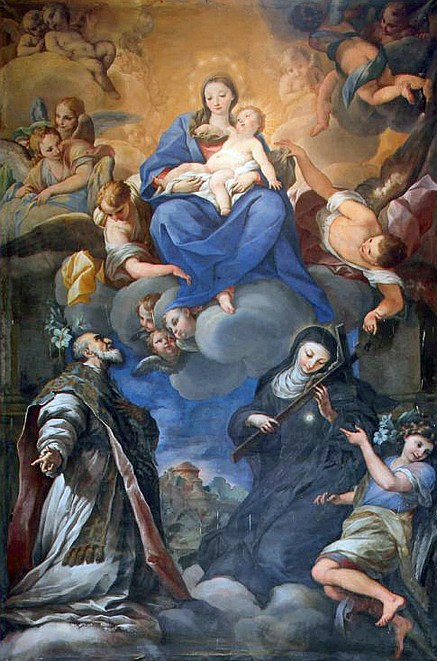 Devotion to Our Lady under this title originated principally in Italy from three main sources – St. Philip Benizi
and the Order of the Servites, an apparition of Our Lady to the shepherd Bartolomeo Coppa in 1521, and the Clerics Regular of St. Paul
(or Barnabites), founded by St. Anthony Mary Zaccaria.
Devotion to Our Lady under this title originated principally in Italy from three main sources – St. Philip Benizi
and the Order of the Servites, an apparition of Our Lady to the shepherd Bartolomeo Coppa in 1521, and the Clerics Regular of St. Paul
(or Barnabites), founded by St. Anthony Mary Zaccaria.
From St. Philip Benizi to Puerto Rico
St. Philip Benizi (image right), the fifth General of the Servants of Mary
(Servites), is commonly credited with the beginning of devotion to Our Lady under the title of Madonna of Divine Providence.
It is said that one day when his religious brethren had nothing left to eat, St. Philip recommended that they call upon the intercession
of Our Lady, who had procured the first miracle of Our Divine Lord at Cana. Later they found an abundance of food had been left at the
door of their convent.
The Servants of Mary began spreading this devotion throughout Italy, France and Spain – including Catalonia.
Centuries later, a native of Catalonia, Gil Estévez y Tomás, was nominated in 1848 to be the forty-first Bishop of Puerto Rico.
He brought to the island the devotion to Our Lady of Divine Providence, which he had practiced especially during his seminary years.
When he arrived he found the cathedral practically in ruins, and the economy of the diocese in an even worse condition.
Entrusting his entire diocese into the hands of Divine Providence and confident in Mary's intercession, the new Bishop made rapid
progress – the cathedral was entirely rebuilt within five years, and the devotion to Our Lady of Divine Providence was solidly established.
Bishop Estévez ordered an image of the Virgin of Providence to be made in Barcelona according to the style of those times –
which required the statue to be clothed with elaborate vestments. This statue was enshrined in the Cathedral of San Juan for 67 years –
until 1920 – when it was replaced by the image (on home page), entirely carved in wood, which can
still be seen today; copies have been enshrined in many churches in America, including St. Patrick's Cathedral in New York City.
The image in Puerto Rico was established as a Marian Shrine in 1925, and Our Lady of Divine Providence was adopted as the Patroness
of Puerto Rico.
Apparition of Our Lady of Divine Providence
The Shrine in Puerto Rico was not the first in honor of Our Lady of Divine Providence. That honor is claimed by the
Santuario Madre della Divina Provvidenza in Cussanio, a rural district in the Diocese of Fossano, Italy. This Shrine has its
origin in an apparition of Our Lady to the shepherd, Bartolomeo Coppa, who had been deaf and mute from birth. He was of vulgar
appearance, stature and dress, and unknown to the world until May 9, 1521, when he saw a great Lady
dressed in white
(image below), who approached him with maternal affection. With Her blessing, the Lady instantly cured the deaf-mute and
entrusted him with a mission. Bartolomeo was to preach repentance to the inhabitants of Fossano, and to proclaim that the justice
of God would inflict them with a deadly scourge if they did not repent. Then the Lady vanished.
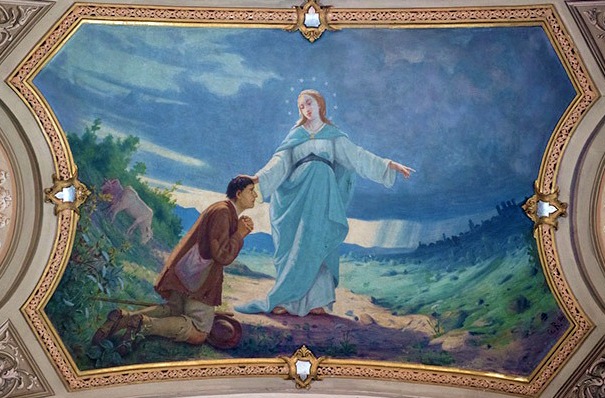
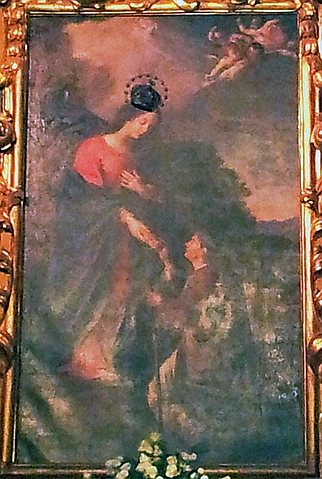
Bartolomeo did as he was told, and for three long days the former deaf-mute preached unceasingly, but without success.
Tired, hungry and dejected, he returned to the place of the apparition and fell asleep on the ground. Our Lady, who never abandons
those who trust in Her, appeared a second time (image left), but dressed in blue. She gave the hungry youth three loaves of bread, and bid him
continue his mission. He did so, but again met with ridicule and disbelief.
All this changed when, in October of the same year, a terrible plague broke out in the region. At the sight of thousands
of victims, death and desolation, the people remembered the preaching and warnings of Bartolomeo. Now that the predicted chastisement
had come, they finally decided to repent. The plague soon subsided and a small chapel was erected at the site of the apparition, where
the grateful people invoked Our Lady as the Mother of Divine Providence. Before long, pilgrimages began arriving at the new shrine.
In 1600 the Augustinian Friars of the Genoa Congregation arrived and eventually replaced the chapel with a large church,
together with a grand monastery complex. The importance and prosperity of the Cussanio sanctuary grew between the 17th and 18th
centuries. However, the upheavals that occurred with the French Revolution greatly affected the Sanctuary which experienced a
period of decline in those years: the Augustinian Fathers were forced to leave the convent and never returned, even after the
restitution of the properties to the Church. The rebirth of the Sanctuary was possible only with the arrival in the diocese of
Bishop Emiliano Manacorda in 1872 – a friend of St. John Bosco – who claimed ownership of the monastery that had been wrongfully
confiscated by the state, and decided upon the complete renovation of the Sanctuary. Work began shortly after 1875 and continued
for about twenty years, and included the elevation of the majestic dome and the reconstruction of the entire façade. The nave was
extended, two aisles built and the interior was adorned with altars, sculptures and paintings. Two of the paintings, attributed to
the painter Giuseppe Barotto, depict the two apparitions mentioned above.
The Barnabites
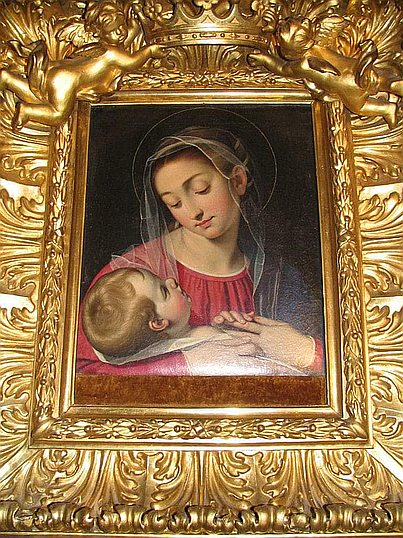 The most well-known image which has been given the name Mother of Divine Providence, as well as the proper Mass in Her
honor, have their origin in the Religious Congregation known as the Clerics Regular of St. Paul or the Barnabites. The Congregation
was founded in 1553 by St. Anthony Mary Zaccaria, who had instilled in his spiritual children a great love for Mary, whose name he bore.
The Saint died in 1539, before reaching his 37th year.
The most well-known image which has been given the name Mother of Divine Providence, as well as the proper Mass in Her
honor, have their origin in the Religious Congregation known as the Clerics Regular of St. Paul or the Barnabites. The Congregation
was founded in 1553 by St. Anthony Mary Zaccaria, who had instilled in his spiritual children a great love for Mary, whose name he bore.
The Saint died in 1539, before reaching his 37th year.
Devotion to Mary, Mother of Divine Providence began in the first house of the Congregation in Rome at the Church of
San Carlo ai Catinari, around the year 1611. The magnitude of the initial difficulties in financing the construction of the church,
and later, the disastrous crumbling of the miraculous mural of the Blessed Virgin Mary, were unable to shatter the belief of Father Palma,
the first pastor of the church, in the power of Mary's providential assistance. One of the Barnabites traveled to the Sanctuary
of Loreto, to pray for assistance in finding the financial resources to complete the Church of San Carlo. Upon his return they
received the needed finances, and so began their own devotion to Our Mother of Divine Providence.
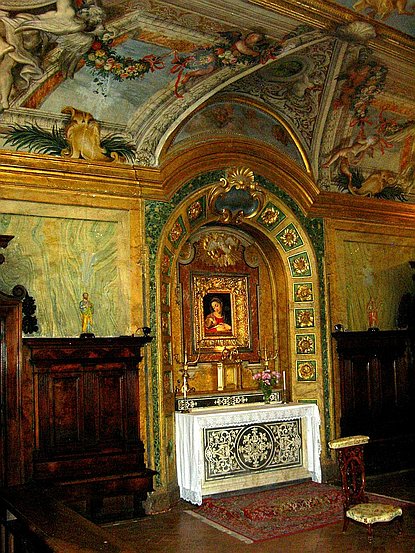 In 1663, the Barnabites were offered a remarkable painting of the Blessed Mother holding the Infant Jesus in her arms
by the artist Scipione Pulzone (ca. 1550-1598). It was before her image that the Barnabite Fathers used to gather for their
daily prayers. Public devotion to Mary, Mother of Divine Providence, did not begin until much later. In July 1732, an exact copy
of the original painting was placed in a location adjacent to the main altar of the church of San Carlo ai Catinari with the
inscription, Mater Divinae Providentiae. The exposition of the painting for public veneration resulted in a great increase
of devotion among the faithful. Numerous graces and favors were obtained through the intercession of Mary.
In 1663, the Barnabites were offered a remarkable painting of the Blessed Mother holding the Infant Jesus in her arms
by the artist Scipione Pulzone (ca. 1550-1598). It was before her image that the Barnabite Fathers used to gather for their
daily prayers. Public devotion to Mary, Mother of Divine Providence, did not begin until much later. In July 1732, an exact copy
of the original painting was placed in a location adjacent to the main altar of the church of San Carlo ai Catinari with the
inscription, Mater Divinae Providentiae. The exposition of the painting for public veneration resulted in a great increase
of devotion among the faithful. Numerous graces and favors were obtained through the intercession of Mary.
This Marian side chapel was a particular favorite of many Supreme Pontiffs. Pope Benedict XIV made an annual visit
to the chapel. On February 2, 1815, Pope Pius VII in acknowledging that he owed his return to the Eternal City (after his captivity
under Napoleon Bonaparte) to the protection of Mary, visited the chapel and declared the altar perpetually privileged. Pope Pius IX
spent the first years of his priestly life near the chapel of Mary, Mother of Divine Providence. More than once, he celebrated
Holy Mass at the altar, offering to Mary the chasuble he wore on the day of the proclamation of the Dogma of the Immaculate Conception
in 1854, which still remains in the Church. In 1888, Pope Leo XIII ordered the solemn crowning of the Miraculous Madonna and approved
the Mass and Office of Mary, Mother of Divine Providence, to be celebrated on the Saturday before the third Sunday of November.
Saint Pius X showed his devotion to the Madonna of San Carlo ai Catinari by granting permission for the Votive Mass of Mary,
Mother of Divine Providence on all Saturdays of the year. He also approved her scapular. This is only a glimpse of the living
history of the miraculous image of Mary, Mother of Divine Providence.
On August 5, 1896, Fr. Benedict Nisser, the Superior General of the Barnabites, decreed that every Barnabite house
should have a copy of the painting. Over the years the love for Mary, Mother of Divine Providence has spread throughout the world.
Churches, chapels, altars and houses have been dedicated to her honor. In the United States, Our Lady of Divine Providence is honored
as the Patroness of the State of Indiana and the Diocese of Providence, Rhode Island.
Back to "In this Issue"
Back to Top
Alphabetical Index; Calendar List of Saints
Contact us: smr@salvemariaregina.info
Visit also: www.marienfried.com


 Devotion to Our Lady under this title originated principally in Italy from three main sources – St. Philip Benizi
and the Order of the Servites, an apparition of Our Lady to the shepherd Bartolomeo Coppa in 1521, and the Clerics Regular of St. Paul
(or Barnabites), founded by St. Anthony Mary Zaccaria.
Devotion to Our Lady under this title originated principally in Italy from three main sources – St. Philip Benizi
and the Order of the Servites, an apparition of Our Lady to the shepherd Bartolomeo Coppa in 1521, and the Clerics Regular of St. Paul
(or Barnabites), founded by St. Anthony Mary Zaccaria.

 The most well-known image which has been given the name Mother of Divine Providence, as well as the proper Mass in Her
honor, have their origin in the Religious Congregation known as the Clerics Regular of St. Paul or the Barnabites. The Congregation
was founded in 1553 by St. Anthony Mary Zaccaria, who had instilled in his spiritual children a great love for Mary, whose name he bore.
The Saint died in 1539, before reaching his 37th year.
The most well-known image which has been given the name Mother of Divine Providence, as well as the proper Mass in Her
honor, have their origin in the Religious Congregation known as the Clerics Regular of St. Paul or the Barnabites. The Congregation
was founded in 1553 by St. Anthony Mary Zaccaria, who had instilled in his spiritual children a great love for Mary, whose name he bore.
The Saint died in 1539, before reaching his 37th year. In 1663, the Barnabites were offered a remarkable painting of the Blessed Mother holding the Infant Jesus in her arms
by the artist Scipione Pulzone (ca. 1550-1598). It was before her image that the Barnabite Fathers used to gather for their
daily prayers. Public devotion to Mary, Mother of Divine Providence, did not begin until much later. In July 1732, an exact copy
of the original painting was placed in a location adjacent to the main altar of the church of San Carlo ai Catinari with the
inscription, Mater Divinae Providentiae. The exposition of the painting for public veneration resulted in a great increase
of devotion among the faithful. Numerous graces and favors were obtained through the intercession of Mary.
In 1663, the Barnabites were offered a remarkable painting of the Blessed Mother holding the Infant Jesus in her arms
by the artist Scipione Pulzone (ca. 1550-1598). It was before her image that the Barnabite Fathers used to gather for their
daily prayers. Public devotion to Mary, Mother of Divine Providence, did not begin until much later. In July 1732, an exact copy
of the original painting was placed in a location adjacent to the main altar of the church of San Carlo ai Catinari with the
inscription, Mater Divinae Providentiae. The exposition of the painting for public veneration resulted in a great increase
of devotion among the faithful. Numerous graces and favors were obtained through the intercession of Mary.